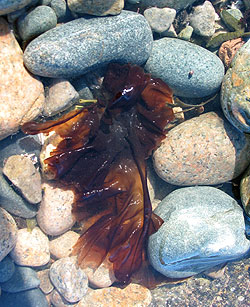
P. umbilicalis (courtesy of Nicolas Blouin, University of Maine)
Red algae play an important role in carbon and nitrogen cycles in the ocean, and are potential biomass for biofuel production. However, few red algae have been studied at the genomic level to date. An international collaboration of researchers has found that some species of the extremophilic red algae Porphyra have a pathway similar to the one used by plants to synthesize fatty acids, a process which leads to the conversion of these lipids into fuel and other chemicals.
Researchers from the DOE Joint Genome Institute sequenced the transcriptome– the record of the proteins the cell is making at the time – of Porphyra umbilicalis and the expression sequenced tags – segments of DNA that identify genes – of Porphyra purpurea as part of the 2008 Community Sequencing Program. Researchers found that the red algae shared many similar mechanisms governing fatty acid production, but key processes are missing, such as production of certain types of fat and transportation of fat outside the plastids, storage compartments inside the cell. Scientists also found enzymes in this pathway similar to those in fungi.
While shedding light on a critical biological process that may be exploited to synthesize biofuels, the research also provides a framework for analyzing transcriptomes in red algae in the future. Their findings were published online in the August 28, 2012 issue of the Journal of Phycology.